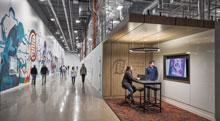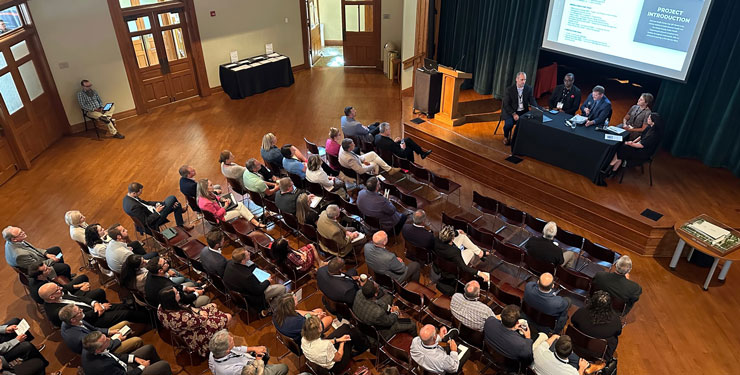
The Patient Experience: Design’s Impact On The Bottom Line

The Hospital Consumer Assessment of Health Providers and Systems (HCAHPS) survey is intended to
measure patient experience, but it only measures patient satisfaction based on medical services
provided. The survey does little to capture the patient experience, which is a missed opportunity.
Patient experience and patient satisfaction are two different concepts; creating and measuring each
requires distinct methods. Different mental, physical, and emotional elements are part of any
experience and should not be overlooked, including the design of the physical environment where an experience occurs.
While it has been established that the patient’s experience during a healthcare visit can impact health outcomes, the connection between design and patient experience has not been thoroughly studied. That’s because of the focus on patient satisfaction via medical treatment instead of the overall healthcare experience. This is partly due to the Medicare reimbursement system’s focus on the HCAHPS survey—facilities with higher satisfaction ratings earn greater reimbursements. While this is understandable, times have changed, and so have potential patients who are much more savvy and discerning consumers of healthcare services. By ignoring the true impact of the overall patient experience, healthcare facilities are missing out on the opportunity to better attract and retain patients, leading to improved bottom lines.
Factors Impacting Healthcare Design
Sustainability and holistic wellness, flexible and adaptable spaces, and the growth of telemedicine are just some of the factors impacting healthcare design. Patient-centered design, though, could have the most significant impact on patient experience. Patient-centered design has evolved from the concept of patient-centered care. It focuses on patients’ unique needs and experiences, unlike the more traditional and established provider-centered design, which focuses on healthcare professionals. As a result, healthcare environments have been designed to move patients in and out of the healthcare system without considering the impact on overall well-being—an example of using design for efficiency while ignoring effectiveness and experience.
While patient-centered design seeks to improve upon provider-centered design, it is essential not to lose sight of the experience for both patients and providers. Doctors, nurses, and staff work best when facilities are adequately staffed and provide ideal working conditions. Focusing on patient experience does not mean diminishing the provider experience.
HCAHPS Survey
The HCAHPS survey measures patient satisfaction with little focus on assessing the overall patient experience—only two of the survey’s 29 questions inquire about the physical environment aspects of a patient’s visit. The answer, however, does not lie in adding more experience-related questions to the HCAHPS survey; lengthening the survey will likely hurt response rates and potentially discourage patients from responding. The solution is to create a different survey or study.
Through additional surveys and interviews, it would be possible to learn more about the impact of healthcare design on patients, families, and caregivers. Another possibility is comparing overall hospital star ratings and patient survey ratings—the driving force behind the HCAHPS Survey—to determine whether highly rated hospitals tend to be facilities that are recognized for their designs through patient feedback, design awards, or press coverage.
Potential questions for a patient experience-related survey include:
- How would you rate the overall ambiance of your room (colors, décor, natural light)
- Was the lighting in your room sufficient and comfortable?
- How easy was it to navigate the hospital and find different departments or services?
- Were the facilities accessible for individuals with mobility challenges?
- Were there adequate measures to ensure the confidentiality of your conversations and treatments?
- Were the hospital facilities well-maintained and in good repair?
Design’s Influence on Outcomes
Another reason adding questions to the HCAHPS survey will not sufficiently address the impact of design is the myriad elements of design that can impact patient experience and influence outcomes. For example, access to natural light improves mood, reduces stress, and even shortens hospital stays. Rooms with large windows and views of nature allow patients to connect with nature (biophilia), which has been proven to have restorative effects to aid healing, not simply to provide a calming and pleasing atmosphere.
Additional design elements that impact patient well-being and experience include private rooms that allow for better rest and recovery to lower the risk of cross-infection, and spaces designed to accommodate family members (lounges, sleeper sofas in patient rooms) to encourage family involvement in healing, leading to better outcomes. An efficient layout can reduce the risk of confusion, which can lead to falls in elderly or cognitively impaired patients. Antimicrobial surfaces and well-ventilated spaces can mitigate the risk of infections. Technology-friendly spaces are needed to support telemedicine and remote monitoring, which can reduce unnecessary hospital visits. Also critical are staff break areas that allow for restorative rest for doctors, nurses, and staff, enabling them to deliver higher-quality care.
Facilities can create the desired experience for people by focusing on the mental, physical, and emotional health of patients, their families, and their caregivers. Think of it as a “build it [experience], and they [patients] will come” moment; more people in the hospital means a stronger bottom line for the facility.
Key Experience Indicators
A focus on patient experience necessitates fresh metrics to evaluate each organization’s progress. This desire to understand how organizations function in all aspects is true across many industries today. One example includes the federal government’s Office of Management and Budget, which has long sought a “coordinated and integrated set of indicators to measure, monitor, and improve organization health and performance.”
Integrating key experience indicators (KXIs) with traditional key performance indicators (KPIs) opens a window into efficiency and experience—equally critical components that provide a holistic picture of organizational health and effectiveness. Organizations can think of KXIs across three distinct categories: the individual (e.g., value, trust, and motivation), the team (e.g., roles, collaboration, and innovation), and the organization (e.g., communication, transparency, and equity).
Hospitals can measure the impact of design changes on experience through a combination of traditional methods (e.g., analog or digital surveys, comment cards, focus groups, and statistics such as numbers of new and existing patients) and newer approaches, such as using a QR code to collect photos from patients, visitors, and employees of their favorite spots within the hospital, where they feel especially comfortable or rejuvenated. Another possibility is creating advisory groups of patients and their families to walk through the hospital quarterly to provide feedback on specific spaces and features that contribute to the patient experience. This approach allows patients to be seen and heard by decision-makers. This could also be done with caregivers to better understand their work experience.
At the Cleveland Clinic in Ohio, the main campus emphasizes patient-centered care through design with private patient rooms, abundant natural light, and easier navigation. The updated facility includes artwork installations and green spaces to enhance the natural healing environment. By focusing on patient comfort and well-being, the facility has created a more positive, comprehensive, healing-friendly environment while easing navigation to reduce stress and confusion. The design updates are linked to increased patient satisfaction scores and improved recovery times, and the integration of art and nature into that design was particularly well-received by patients and visitors. Now, all they need is a way to quantify the impact of those improvements on patient experience.
Failure to capture and capitalize on patient experience data could hinder the future financial growth of healthcare facilities. The roles of telemedicine, automation, and phygital (a combination of physical and digital describing the seamless use of technology to blend the two worlds) experiences will continue to expand. Organizations that successfully integrate aspects of design and experience into patient surveys and create opportunities for patients to share their favorite aspects of the facility experience via social media and other interactive forums will attract new patients through influencing via social media, word-of-mouth referrals, and online reviews. The overall result will have a positive bottom-line impact on healthcare organizations.
This article was originally published by Healthcare Business Today.
Ready to create an exceptional patient experience? Complete our contact form today.
Author
Content Type
Published Articles
Date
September 25, 2024
Market
Practice
Topic
Patient Experience
Healthcare Design



